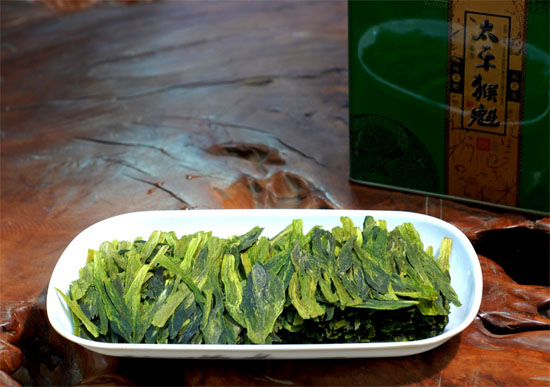Taiping Hou Kui tea is grown at the foot of Huangshan in Taiping County, Anhui. The tea has been produced since the beginning of the 20th century and is produced around the small village of Hou Keng. It won the "King of Tea" award in China Tea Exhibition 2004 and is China Famous Tea.
Tai Ping Hou Kui is grown in the western reaches of Huang Shan’s mountain range in three villages in the Tai Ping prefecture: Hou Keng, Hou Gan, Yan Jia. These villages surround a large lake that is kept full with a dam and sits at an altitude of 700M above sea level. Here there is big difference in temperature between day and night, a condition that is said to make a special flavor in tea. Humidity and fog from the lake create ideal moisture and shade for tea plants, and the area’s soil is dark and mineral rich. Its fine grains are loose, well drained, and permeable, but still retain moisture. Seventy-three percent of the gardens are grown on the back slope of the mountain, that is they are grown on the opposite side of the sun’s east-west path. The mountain is very steep and must be climbed to harvest and care for the tea, a demanding climb and descent. These bushes are mostly shaded from direct sunlight. Tea grown under the shade will have increased nutrition and sweetness.
It is renowned for its "two knives and one pole": two straight leaves clasping the enormous bud with white hairs. The oven-made leaves are deep green in color with red veins underneath. The tea shoots can be as long as 15 centimetres. They are plucked from the Shi Da Cha, a large leaf-variety found only in Anhui Province.The tea has an orchid fragrance. The first infusion is said to be aromatic, second full bodied, 3rd and 4th pleasantly scented. It is famous for the Monkey Rhyme (Hou Yun), a sweet aftertaste that can be found only in the best of Tai Ping Hou Kui tea.

Picking:
Harvesting takes place once a year in Spring - for just 2 weeks.Picking starts when 20% of the tea shoots acquires one bud with 3 slightly unfurled leaves. Traditionally, this takes place around 20 April to 5 May. But climate changes have shifted the season forward.After picking, the tea shoots are made by hand in the same day.
Making Process:
Lianjian breaks off the top end of the tea shoots for further processing. A high grade can be 15 centimetres long, which is then baked to about 5 centimetres.
Shaqing applies low heat to a large wok to kill the enzymes and halt the fermentation process. The process lasts 2 to 3 minutes. The wok has a relatively constant temperature at around 110 degree Celsius.
Maohong, erhong and tuolaohong oven and press the leaves so that they are straight, flat and clasping the buds. Temperature reduces from 100 to 60 degree Celsius.
What does the name of this fascinating tea mean?
Tai Ping is the name of the county. Hou Kui is the name of the tea.The tea is named after houkeng, the place where the tea was first made famous. Houkeng means Monkey Pit, so called because it is a mountain valley where people took shelter during wartime.The word "Kui" comes from the name of the tea farmer - Wang Kui Chen - who invented it in the early 19th century. Kui also means large or chief. High grade Chinese green tea is usually small and delicate. Not the Hou Kui tea. It is celebrated for its large leaves and buds.

![Diseases, Symptoms, tcm, [tcmwindow.com]](/uploadFile/adImg/2015/11/11/f5cbfcc0-4df5-4646-9b9a-f316651a0199.jpg)





